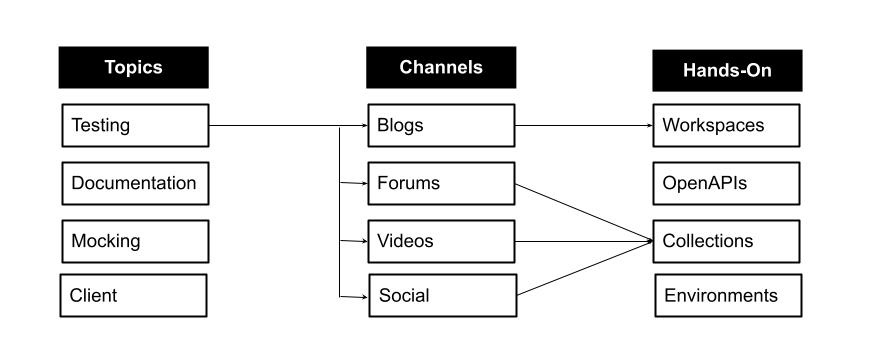
I was sharing my personal algorithm for how I approach evangelism. It isn’t very complex but is something I have evolved over the last decade plus and kept interesting through switching up the topics I focus on and which channels I use to engage with my audience. While there is a lot of nuances to how I personally approach as the API Evangelist or Chief Evangelist, it goes something like this.
 I usually have a handful of topics that are of priority to me each week, and based upon my audience I will use a mix of channels to produce and deliver content for each topic. One of the most meaningful aspects of this for me centers on making it all hands-on in a workspace. In this case I am developing tests as collections, but when I switch to documentation, I’ll focus on other ways to make things hands-on.
I usually have a handful of topics that are of priority to me each week, and based upon my audience I will use a mix of channels to produce and deliver content for each topic. One of the most meaningful aspects of this for me centers on making it all hands-on in a workspace. In this case I am developing tests as collections, but when I switch to documentation, I’ll focus on other ways to make things hands-on.
 I work my way through each topic, creating blog posts, searching, starting, and participating in forum conversations, while also creating videos, and broadcasting then engaging via social media. Whenever possible I produce an OpenAPI, collection, and possibly an environment to demonstrate whatever it is I am talking about in my blog post, video, on the forum, or via social media. Which for me, adds a meaningful set of metrics for me to consider.
I work my way through each topic, creating blog posts, searching, starting, and participating in forum conversations, while also creating videos, and broadcasting then engaging via social media. Whenever possible I produce an OpenAPI, collection, and possibly an environment to demonstrate whatever it is I am talking about in my blog post, video, on the forum, or via social media. Which for me, adds a meaningful set of metrics for me to consider.
 While evaluating the success of my evangelism I take into considering the views, likes, and shares on the content distributed via each of the channels. However, it is the views, watches, and forks that show me what stuck with my audience when it comes to things being hands-on. Reading something, watching a video, and liking or sharing is low bar metric, but someone forking and watching an example of how to do something can have potentially more value.
You can get as detailed oriented or as loose as you want about this as you like. You can switch up topics and channels, and you can do without using workspaces, but I feel like it adds a meaningful depth to it when it comes to developers. You can also add in-person meetups and conferences into the channel mix and use workspaces as a powerful way to measure engagement with in-person engagement. There is a lot of flexibility in this algorithm, but I like that it provides a structured way for me to approach my work, allowing me to measure my impact without getting too caught up in funnels, metrics, and other distractions.
An example of this in action can be found with Joyce Lin’s work, my Director of Developer relations, with her Lost in Space production, which I think is an amazingly creative look at how this algorithm works:
While evaluating the success of my evangelism I take into considering the views, likes, and shares on the content distributed via each of the channels. However, it is the views, watches, and forks that show me what stuck with my audience when it comes to things being hands-on. Reading something, watching a video, and liking or sharing is low bar metric, but someone forking and watching an example of how to do something can have potentially more value.
You can get as detailed oriented or as loose as you want about this as you like. You can switch up topics and channels, and you can do without using workspaces, but I feel like it adds a meaningful depth to it when it comes to developers. You can also add in-person meetups and conferences into the channel mix and use workspaces as a powerful way to measure engagement with in-person engagement. There is a lot of flexibility in this algorithm, but I like that it provides a structured way for me to approach my work, allowing me to measure my impact without getting too caught up in funnels, metrics, and other distractions.
An example of this in action can be found with Joyce Lin’s work, my Director of Developer relations, with her Lost in Space production, which I think is an amazingly creative look at how this algorithm works:
Joyce is a master at this stuff, and I highly recommend tuning into what she does from time to time. She is also pioneering and rocking the TikTok channel, pushing this algorithm into new channel territory. The diversity of this approach is what keeps me interested and hustling each day as an evangelist.
